Winter and Wildfire Season Optical Characterization of Black and Brown Carbon in the El Paso-Ciudad Juárez Airshed
Abstract
:1. Introduction
2. Methodology
2.1. Site Description and Terrain
2.2. Instrumentation
2.2.1. Photoacoustic Extinctiometer
2.2.2. Ceilometer
2.3. Instrument Calibration and Data Processing
2.3.1. Calibration Procedure for Pax Scattering and Absorption
2.3.2. Absorption Coefficient Baseline, Event Days and Carbon Monoxide
TCEQ Carbon Monoxide
2.3.3. Angstrom Exponent and Brown Carbon Derivation
Ångstrom Exponent
Brown Carbon Derivation
2.4. Air Mass Trajectory Analysis
3. Analysis
3.1. EBC and BrC Winter Season Characterization
Single Scattering Albedo and the Ångstrom Exponent for the Winter Season
3.2. EBC and BrC Summer Wildfire Seasonal Characterization
3.2.1. The Single Scattering Albedo (SSA) and the Absorption Ångstrom Exponent for the Summer Season
3.2.2. HRRR and HYSPLIT for the Wildfire Event Days
3.2.3. Composite Synoptic Conditions and PBL Structure during the Wildfire Exceedance Events
4. Discussion and Conclusions
Author Contributions
Funding
Institutional Review Board Statement
Informed Consent Statement
Data Availability Statement
Acknowledgments
Conflicts of Interest
References
- Polanco Gonzalez, J. An Improved Method for Optical Characterization of Mineral Dust and Soot Particles in the El Paso-Juárez Airshed. Available online: http://148.210.21.170/handle/20.500.11961/16767 (accessed on 2 November 2021).
- Karle, N.N. Studies of the Planetary Boundary Layer and Their Impact on Air Pollution in a Semi-Arid Region with Complex Terrain. Ph.D. Thesis, The University of Texas at El Paso, El Paso, TX, USA, 2021. [Google Scholar]
- Karle, N.N.; Mahmud, S.; Sakai, R.K.; Fitzgerald, R.M.; Morris, V.R.; Stockwell, W.R. Investigation of the Successive Ozone Episodes in the El Paso–Juarez Region in the Summer of 2017. Atmosphere 2020, 11, 532. [Google Scholar] [CrossRef]
- Petzold, A.; Ogren, J.A.; Fiebig, M.; Laj, P.; Li, S.-M.; Baltensperger, U.; Holzer-Popp, T.; Kinne, S.; Pappalardo, G.; Sugimoto, N.; et al. Recommendations for reporting “black carbon” measurements. Atmos. Chem. Phys. 2013, 13, 8365–8379. [Google Scholar] [CrossRef]
- Grange, S.K.; Lötscher, H.; Fischer, A.; Emmenegger, L.; Hueglin, C. Evaluation of equivalent black carbon source apportionment using observations from Switzerland between 2008 and 2018. Atmos. Meas. Tech. 2020, 13, 1867–1885. [Google Scholar] [CrossRef]
- Andreae, M.O.; Gelencsér, A. Black Carbon or Brown Carbon? The Nature of Light-Absorbing Carbonaceous Aerosols. Atmos. Chem. Phys. 2006, 6, 3131–3148. [Google Scholar] [CrossRef]
- Esparza, A.E.; Fitzgerald, R.M.; Gill, T.E.; Polanco, J. Use of Light-Extinction Method and Inverse Modeling to Study Aerosols in the Paso Del Norte Airshed. Atmos. Environ. 2011, 45, 7360–7369. [Google Scholar] [CrossRef]
- Fitzgerald, R.M.; Karle, N.N.; Lara, P.; Polanco Gonzalez, J.; Stockwell, W.R. Optical Measurements of Particulate Matter in the El Paso-Juarez Region: Natural Mineral Dust and Soot. Environ. Manag. 2021, 2, 11–19. [Google Scholar] [CrossRef]
- Yan, J.; Wang, X.; Gong, P.; Wang, C.; Cong, Z. Review of Brown Carbon Aerosols: Recent Progress and Perspectives. Sci. Total Environ. 2018, 634, 1475–1485. [Google Scholar] [CrossRef]
- Künzi, L.; Mertes, P.; Schneider, S.; Jeannet, N.; Menzi, C.; Dommen, J.; Baltensperger, U.; Prévôt, A.S.H.; Salathe, M.; Kalberer, M.; et al. Responses of Lung Cells to Realistic Exposure of Primary and Aged Carbonaceous Aerosols. Atmos. Environ. 2013, 68, 143–150. [Google Scholar] [CrossRef]
- Stewart, D.R.; Saunders, E.; Perea, R.A.; Fitzgerald, R.; Campbell, D.E.; Stockwell, W.R. Linking Air Quality and Human Health Effects Models: An Application to the Los Angeles Air Basin. Environ. Health Insights 2017, 11, 1178630217737551. [Google Scholar] [CrossRef]
- Hand, J.L.; Kreidenweis, S.M.; Eli Sherman, D.; Collett, J.L.; Hering, S.V.; Day, D.E.; Malm, W.C. Aerosol Size Distributions and Visibility Estimates during the Big Bend Regional Aerosol and Visibility Observational (BRAVO) Study. Atmos. Environ. 2002, 36, 5043–5055. [Google Scholar] [CrossRef]
- Yang, M.; Howell, S.G.; Zhuang, J.; Huebert, B.J. Attribution of Aerosol Light Absorption to Black Carbon, Brown Carbon, and Dust in China–Interpretations of Atmospheric Measurements during EAST-AIRE. Atmos. Chem. Phys. 2009, 9, 2035–2050. [Google Scholar] [CrossRef]
- Kamm, S.; Möhler, O.; Naumann, K.-H.; Saathoff, H.; Schurath, U. The Heterogeneous Reaction of Ozone with Soot Aerosol. Atmos. Environ. 1999, 33, 4651–4661. [Google Scholar] [CrossRef]
- Ammann, M.; Kalberer, M.; Jost, D.T.; Tobler, L.; Rössler, E.; Piguet, D.; Gäggeler, H.W.; Baltensperger, U. Heterogeneous Production of Nitrous Acid on Soot in Polluted Air Masses. Nature 1998, 395, 157–160. [Google Scholar] [CrossRef]
- Vedal, S.; Dutton, S.J. Wildfire Air Pollution and Daily Mortality in a Large Urban Area. Environ. Res. 2006, 102, 29–35. [Google Scholar] [CrossRef] [PubMed]
- Chalbot, M.-C.; Kavouras, I.G.; Dubois, D.W. Assessment of the Contribution of Wildfires to Ozone Concentrations in the Central US-Mexico Border Region. Aerosol Air Qual. Res. 2013, 13, 838–848. [Google Scholar] [CrossRef]
- June, N.A.; Hodshire, A.L.; Wiggins, E.B.; Winstead, E.L.; Robinson, C.E.; Thornhill, K.L.; Sanchez, K.J.; Moore, R.H.; Pagonis, D.; Guo, H.; et al. Aerosol Size Distribution Changes in FIREX-AQ Biomass Burning Plumes: The Impact of Plume Concentration on Coagulation and OA Condensation/Evaporation. Atmos. Chem. Phys. Discuss. 2022, 1–35. [Google Scholar] [CrossRef]
- Claudia, C. Characterization of Temperature Profiles in a Thermodenuder. UC Davis Undergrad. Res. J. 2013, 15, 1–7. [Google Scholar]
- Karle, N.; Mahmud, S.; Fitzgerald, R.; Estes, M.; Walter, P.; Morris, G. Analysis of Boundary Layer Heights Using Ceilometer and Models in the El Paso-Juarez Airshed. In Proceedings of the 101st American Meteorological Society Annual Meeting, Online, 10–15 January 2021. [Google Scholar]
- Washenfelder, R.A.; Flores, J.M.; Brock, C.A.; Brown, S.S.; Rudich, Y. Broadband measurements of aerosol extinction in the ultraviolet spectral region. Atmos. Meas. Tech. 2013, 6, 861–877. [Google Scholar] [CrossRef]
- Kelly, K.; Wagner, D.; Lighty, J.; Núñez, M.Q.; Vazquez, F.A.; Collins, K.; Barud-Zubillaga, A. Black Carbon and Polycyclic Aromatic Hydrocarbon Emissions from Vehicles in the United States–Mexico Border Region: Pilot Study. J. Air Waste Manag. Assoc. 2006, 56, 285–293. [Google Scholar] [CrossRef]
- Shi, Y.; Murr, L.E.; Soto, K.F.; Lee, W.-Y.; Guerrero, P.A.; Ramirez, D.A. Characterization and Comparison of Speciated Atmospheric Carbonaceous Particulates and Their Polycyclic Aromatic Hydrocarbon Contents in the Context of the Paso Del Norte Airshed Along the U.s.-Mexico Border. Polycycl. Aromat. Compd. 2007, 27, 361–400. [Google Scholar] [CrossRef]
- Raysoni, A. Assessment of Intra-Urban Traffic-Related Air Pollution on Asthmatic Children’s Exposure at Schools in the Paso Del Norte Region. Ph.D. Thesis, University of Texas at El Paso, El Paso, TX, USA, 2011. Available online: https://scholarworks.utep.edu/open_etd/2566/ (accessed on 5 July 2022).
- Avitia, A.Y.C.; De la Mora Covarrubias, A. Environmental Assessment of Brick Kilns in Chihuahua State, México, Using Digital Cartography. Funct. Ecosyst. 2012, 14, 261–281. [Google Scholar]
- Montoya, T.; Guarian, P.L.; Velazquez-Angulo, G.; Corella-Barud, V.; Rojo, A.; Graham, J.P. Carbon Monoxide Exposure in Households in Ciudad Juarez, Mexico. Int. J. Hyg. Environ. Health 2008, 211, 40–49. [Google Scholar] [CrossRef]
- Kirchstetter, T.W.; Novakov, T.; Hobbs, P.V. Evidence That the Spectral Dependence of Light Absorption by Aerosols is Affected by Organic Carbon. J. Geophys. Res. 2004, 109, D21208. [Google Scholar] [CrossRef]
- Lack, D.A.; Langridge, J.M. On the Attribution of Black and Brown Carbon Light Absorption Using the Ångström Exponent. Atmos. Chem. Phys. 2013, 13, 10535–10543. [Google Scholar] [CrossRef]
- Zhang, G.; Peng, L.; Lian, X.; Lin, Q.; Bi, X.; Chen, D.; Li, M.; Li, L.; Wang, X.; Sheng, G. An Improved Absorption Angstrom Exponent (AAE)-Based Method for Evaluating the Contribution of Light Absorption from Brown Carbon with High-Time Resolution. Aerosol Air Qual. Res. 2019, 19, 15–24. [Google Scholar] [CrossRef]
- Liu, C.; Chung, C.E.; Yin, Y.; Schnaiter, M. The Absorption Ångström Exponent of Black Carbon: From Numerical Aspects. Atmos. Chem. Phys. 2018, 18, 6259–6273. [Google Scholar] [CrossRef]
- Stein, A.F.; Draxler, R.R.; Rolph, G.D.; Stunder, B.J.B.; Cohen, M.D.; Ngan, F. NOAA’s HYSPLIT Atmospheric Transport and Dispersion Modeling System. Bull. Am. Meteorol. Soc. 2015, 96, 2059–2077. [Google Scholar] [CrossRef]
- Liu, Y.; He, G.; Chu, B.; Ma, Q.; He, H. Atmospheric heterogeneous reactions on soot: A review. Fundam. Res. 2022. preprint. [Google Scholar] [CrossRef]
- Baumgardner, D.G.; Raga, O.; Peralta, I.; Rosas, T.; Castro, T.; Kuhlbusch, A.; John, A.; Petzold, A. Diagnosing Black Carbon Trends in Large Urban Areas Using Carbon Monoxide Measurements. J. Geophys. Res. 2022, 107, ICC-4. [Google Scholar] [CrossRef]
- Bond, T.C.; Bergstrom, R.W. Light Absorption by Carbonaceous Particles: An Investigative Review. Aerosol Sci. Technol. 2006, 40, 27–67. [Google Scholar] [CrossRef]
- Takemura, T.; Nakajima, T.; Dubovik, O.; Holben, B.N.; Kinne, S. Single-Scattering Albedo and Radiative Forcing of Various Aerosol Species with a Global Three-Dimensional Model. J. Clim. 2002, 15, 333–352. [Google Scholar] [CrossRef]
- Schuster, G.; Dubovik, O.; Holben, B.N. Angstrom Exponent and Bimodal Aerosol Size Distribution. J. Geophys. Res. 2006, 111, D07207. [Google Scholar] [CrossRef]
- Karle, N.N.; Fitzgerald, R.M.; Sakai, R.K.; Sullivan, D.W.; Stockwell, W.R. Multi-Scale Atmospheric Emissions, Circulation and Meteorological Drivers of Ozone Episodes in El Paso- Juárez Airshed. Atmosphere 2021, 12, 1575. [Google Scholar] [CrossRef]
- Einfeld, W.; Church, H.W.; Yarbrough, J.W. Winter Season Air Pollution in El Paso-Ciudad Juarez; Region VI, Air, Pesticides & Toxics Division; US Environmental Protection Agency: Washington, DC, USA, 1995.

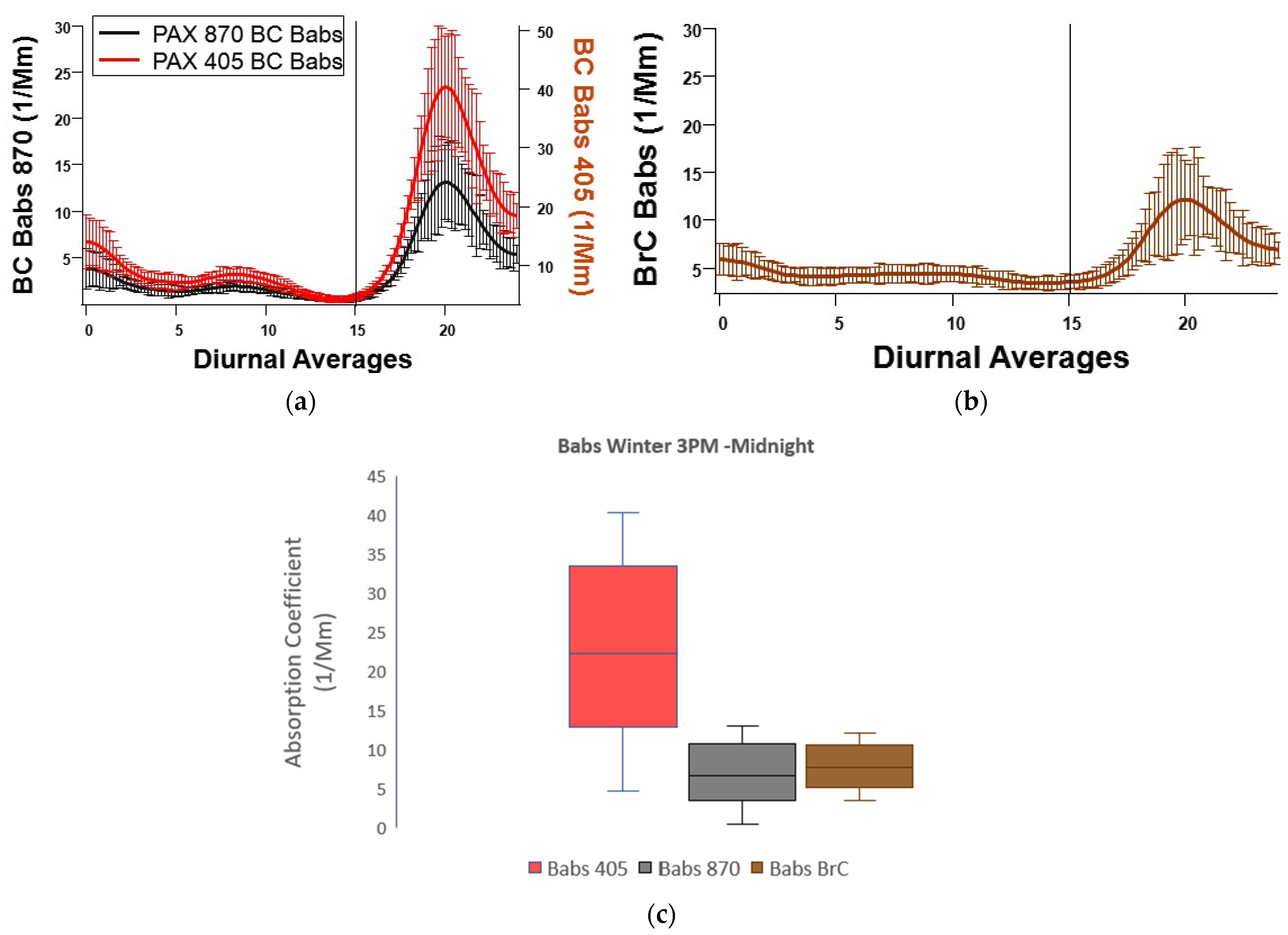
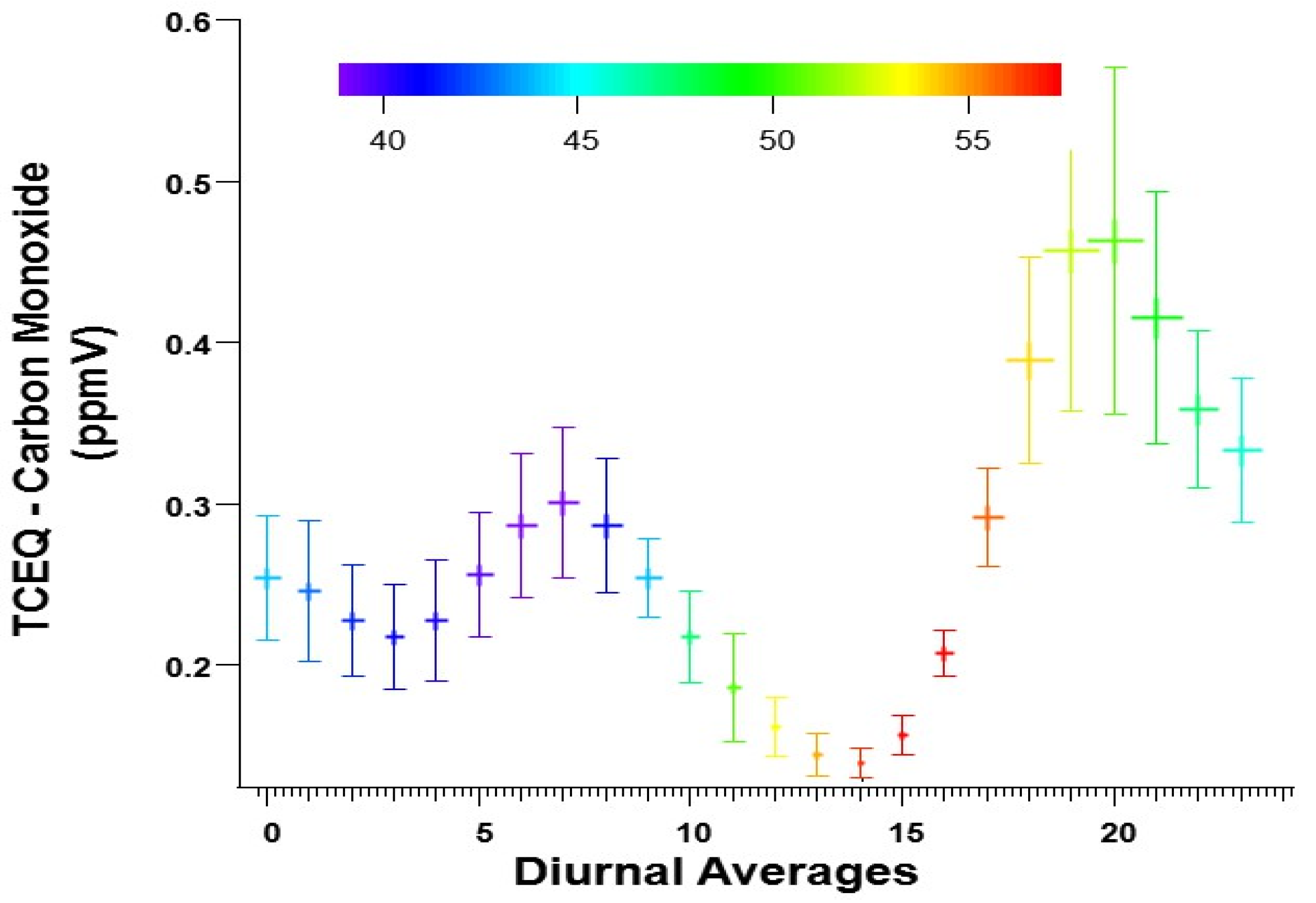

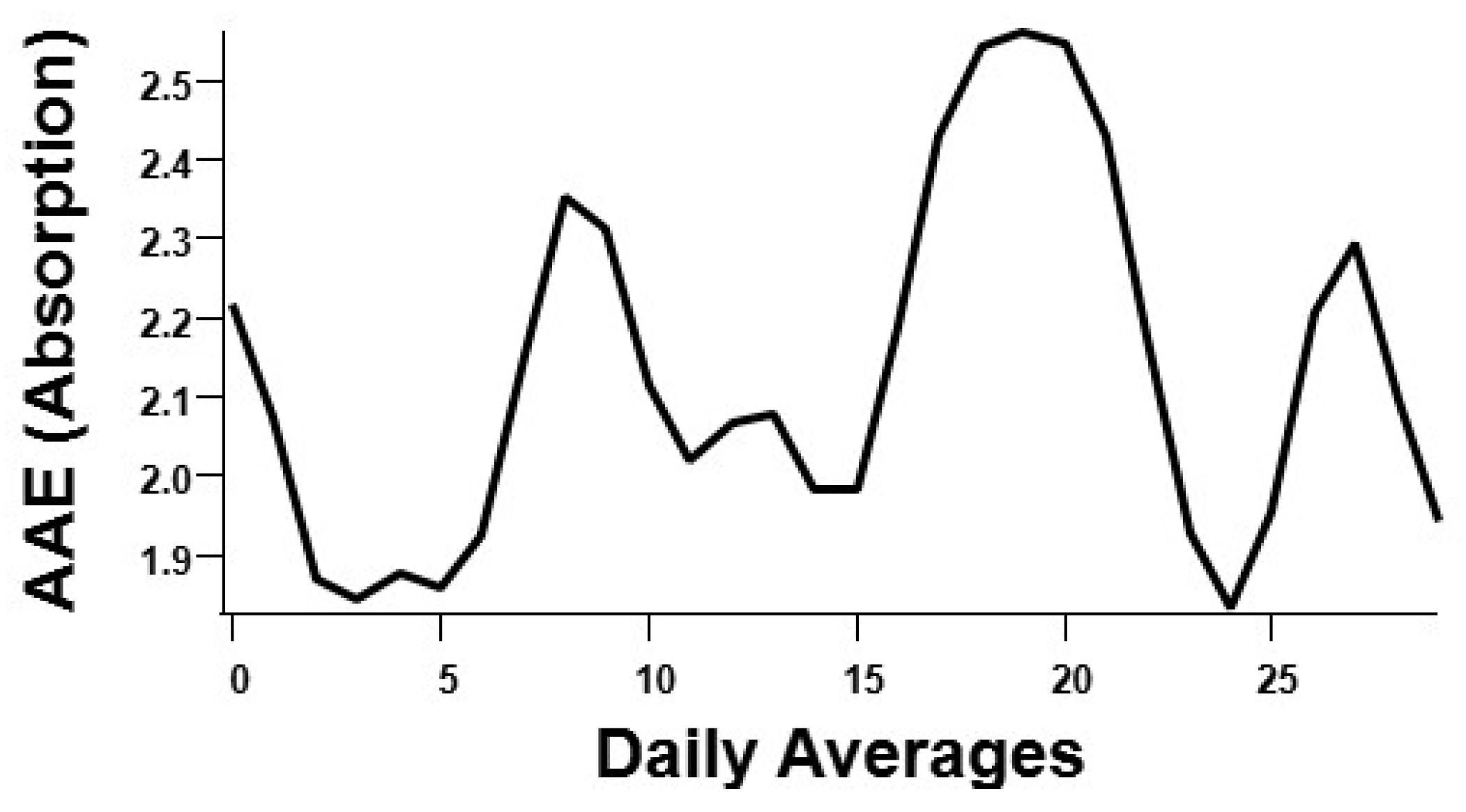
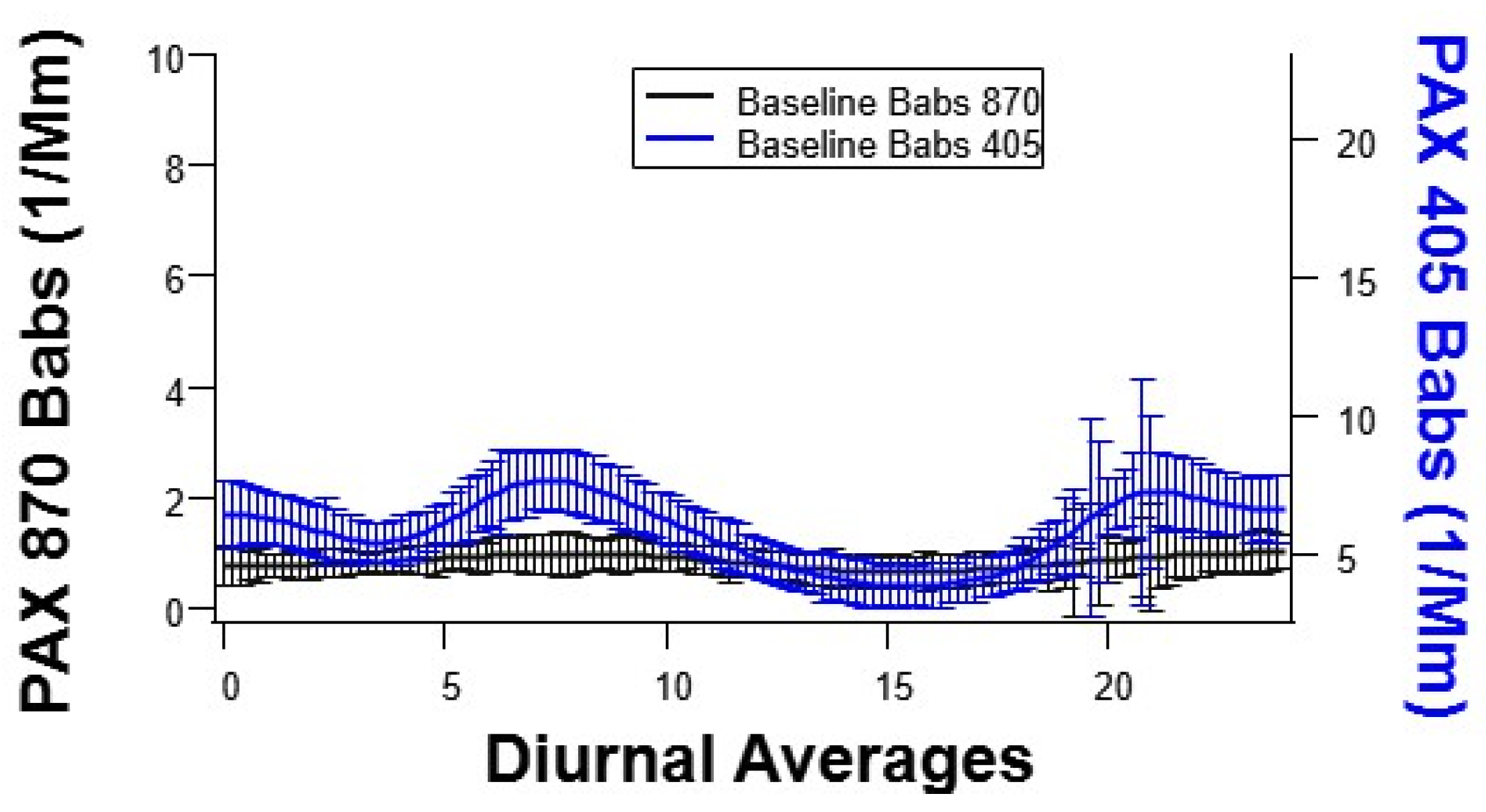

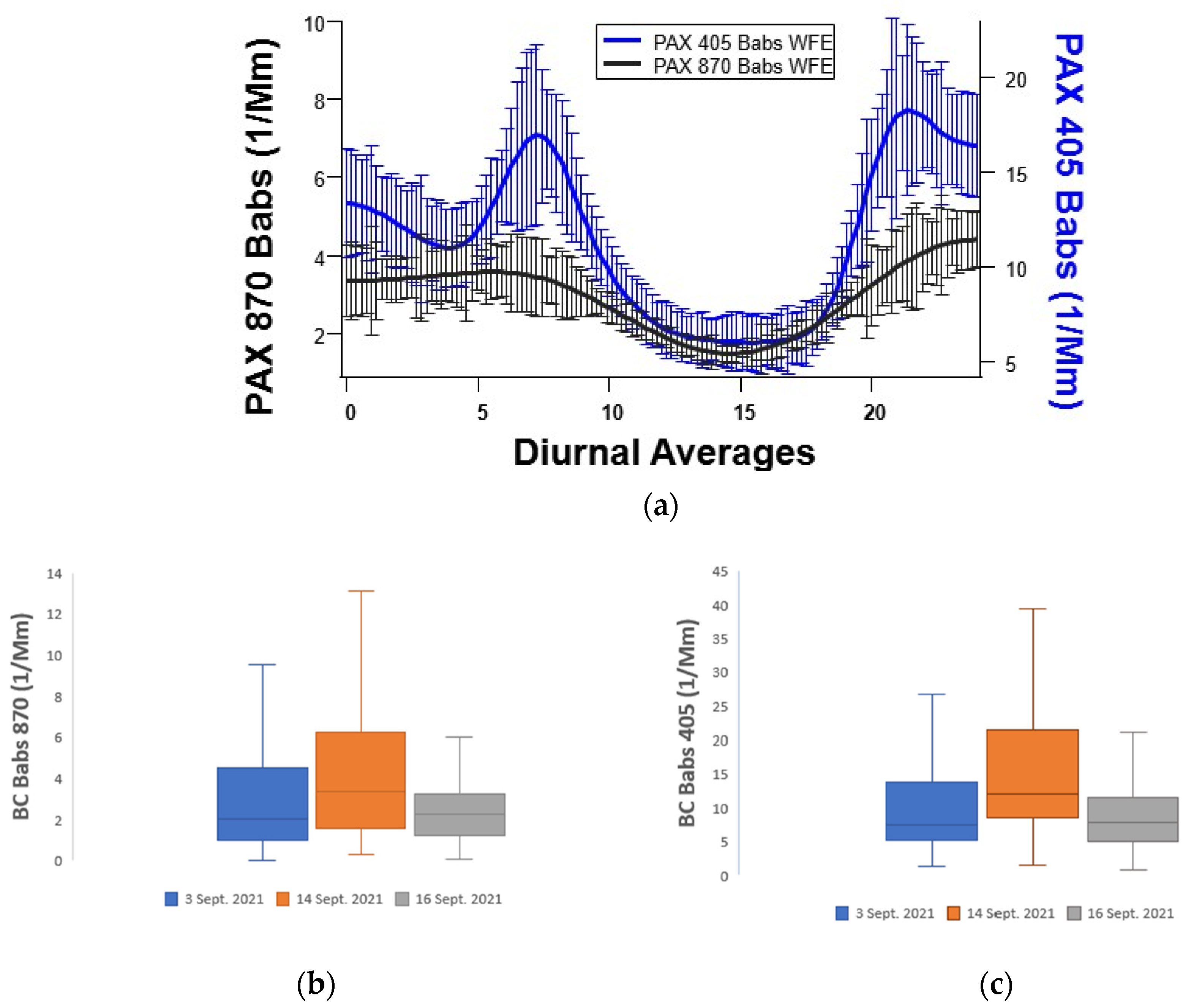
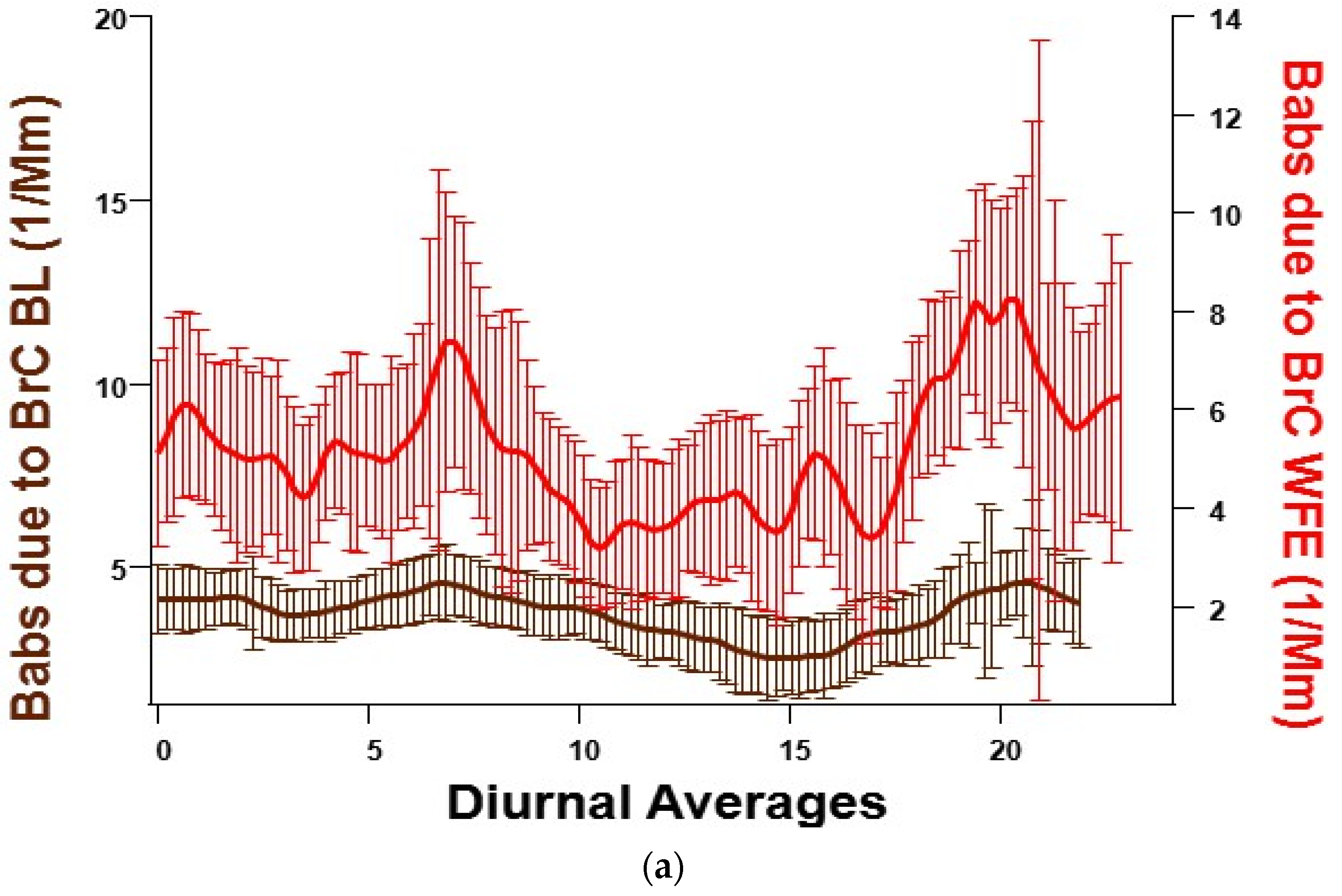
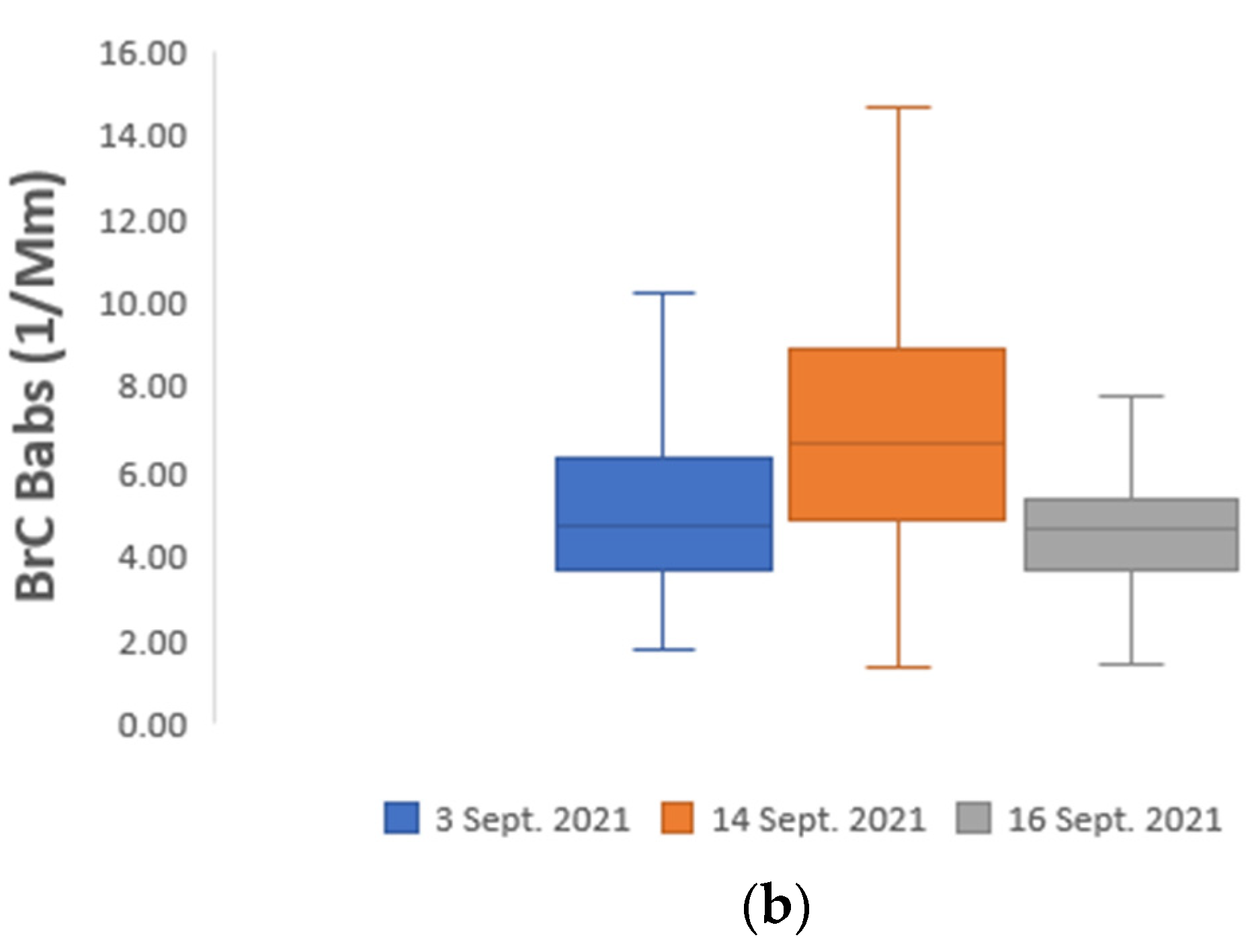
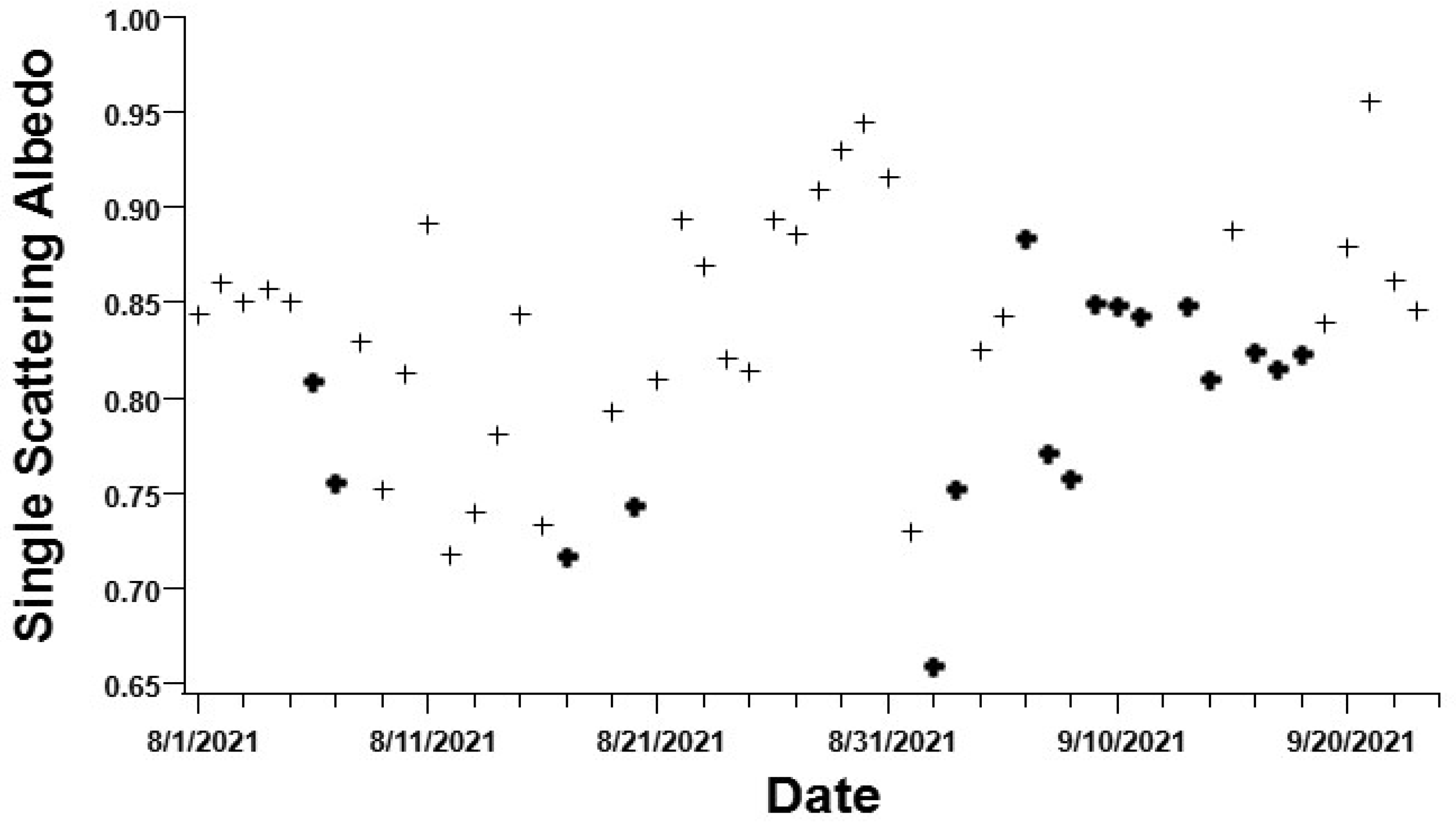
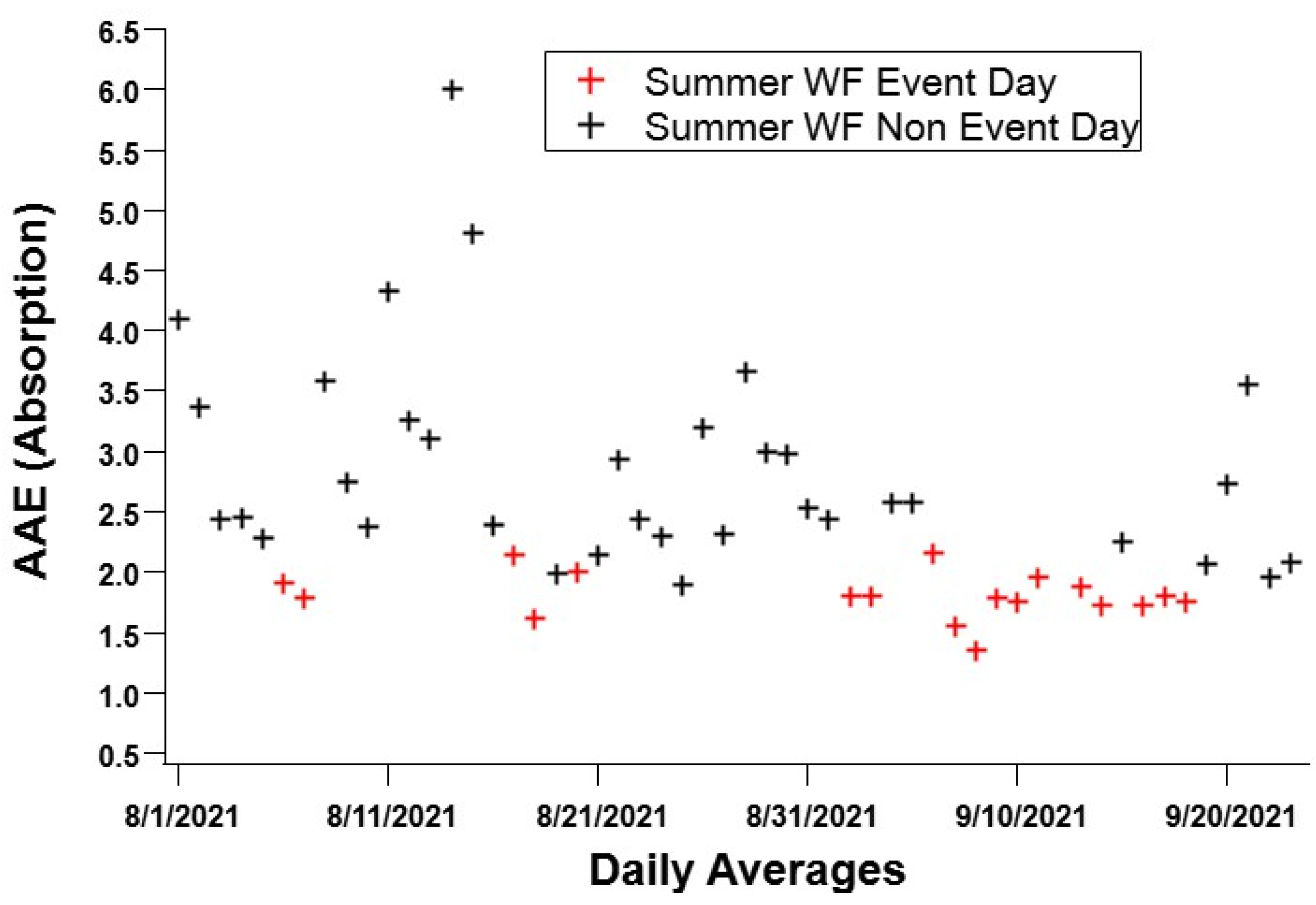
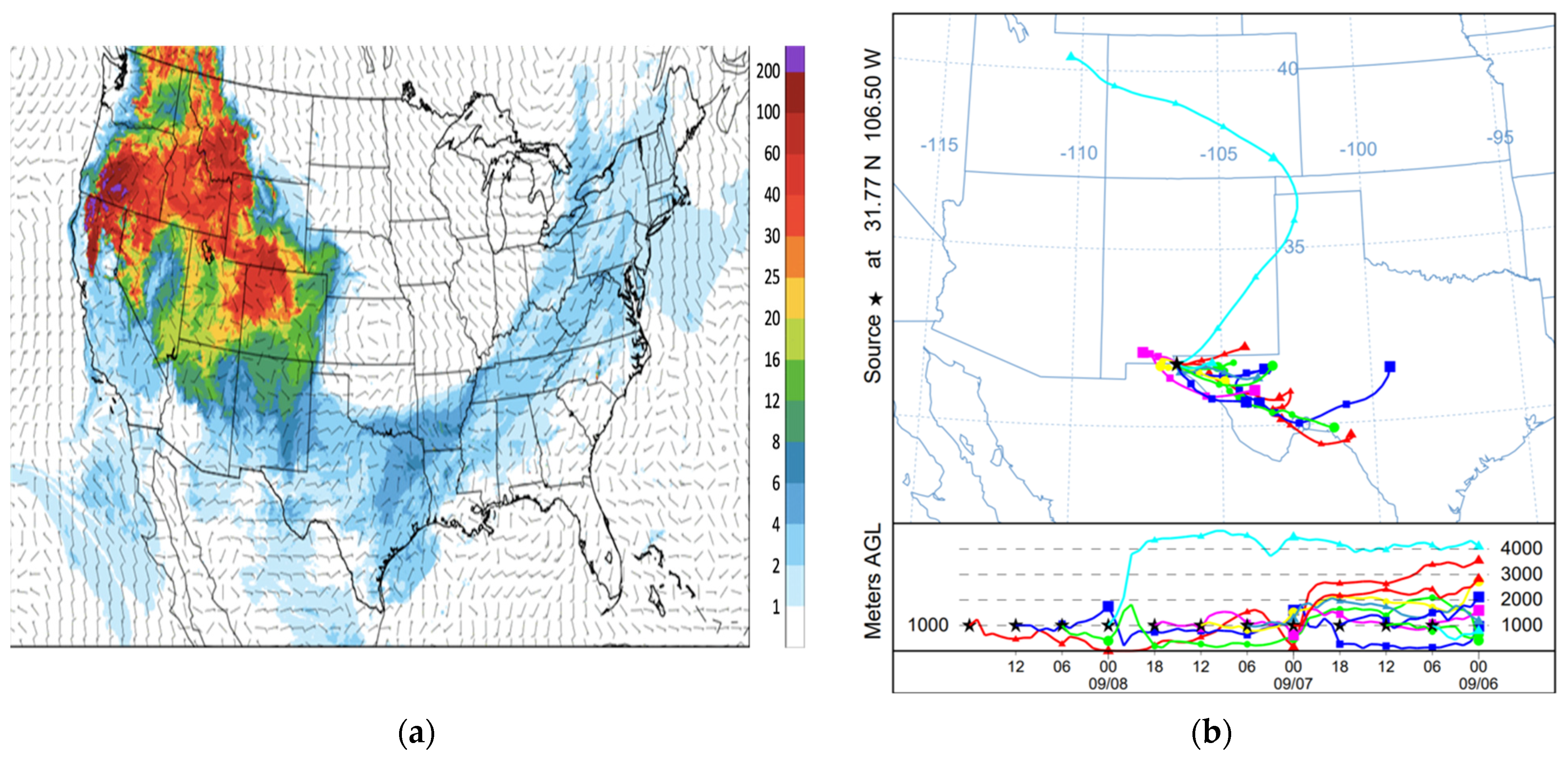
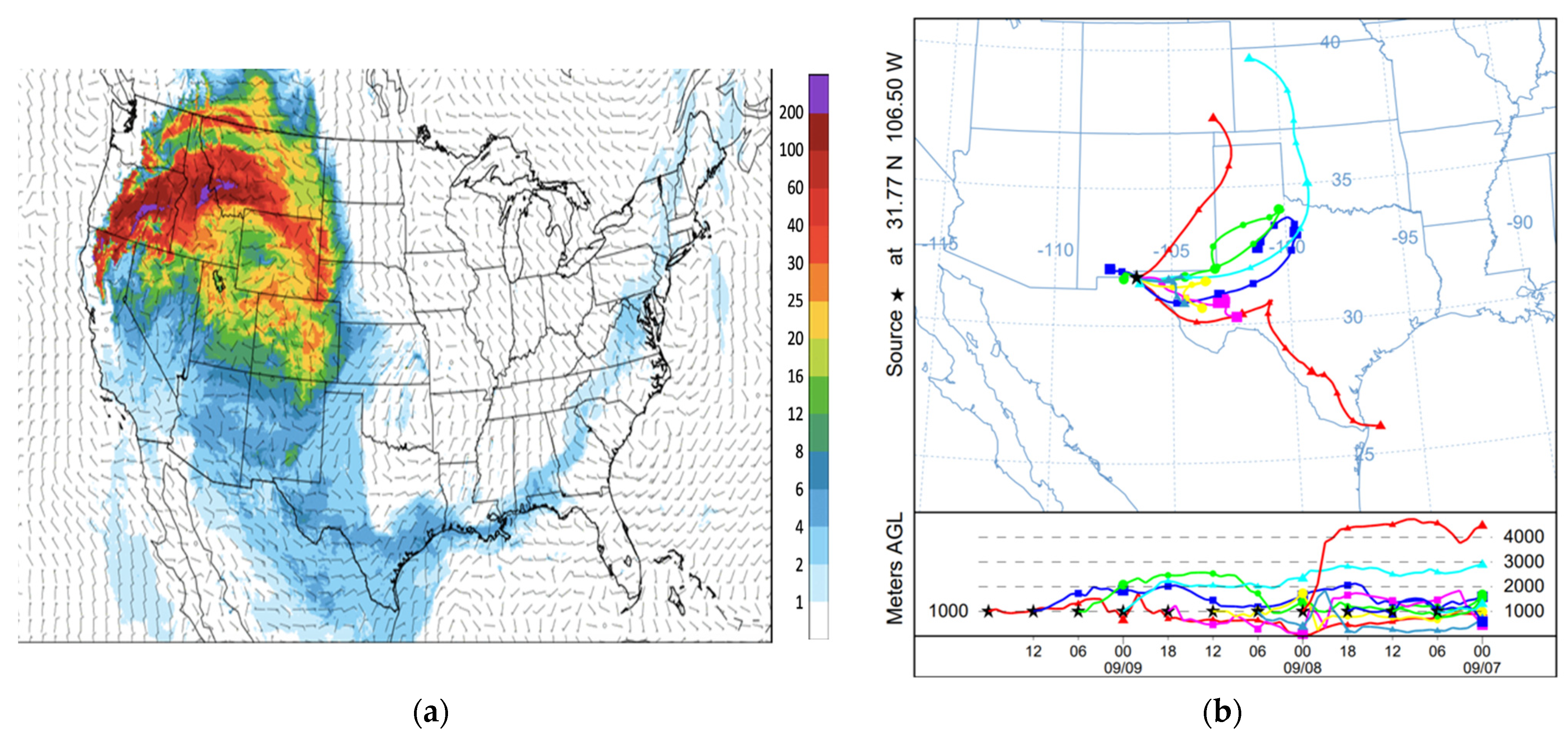
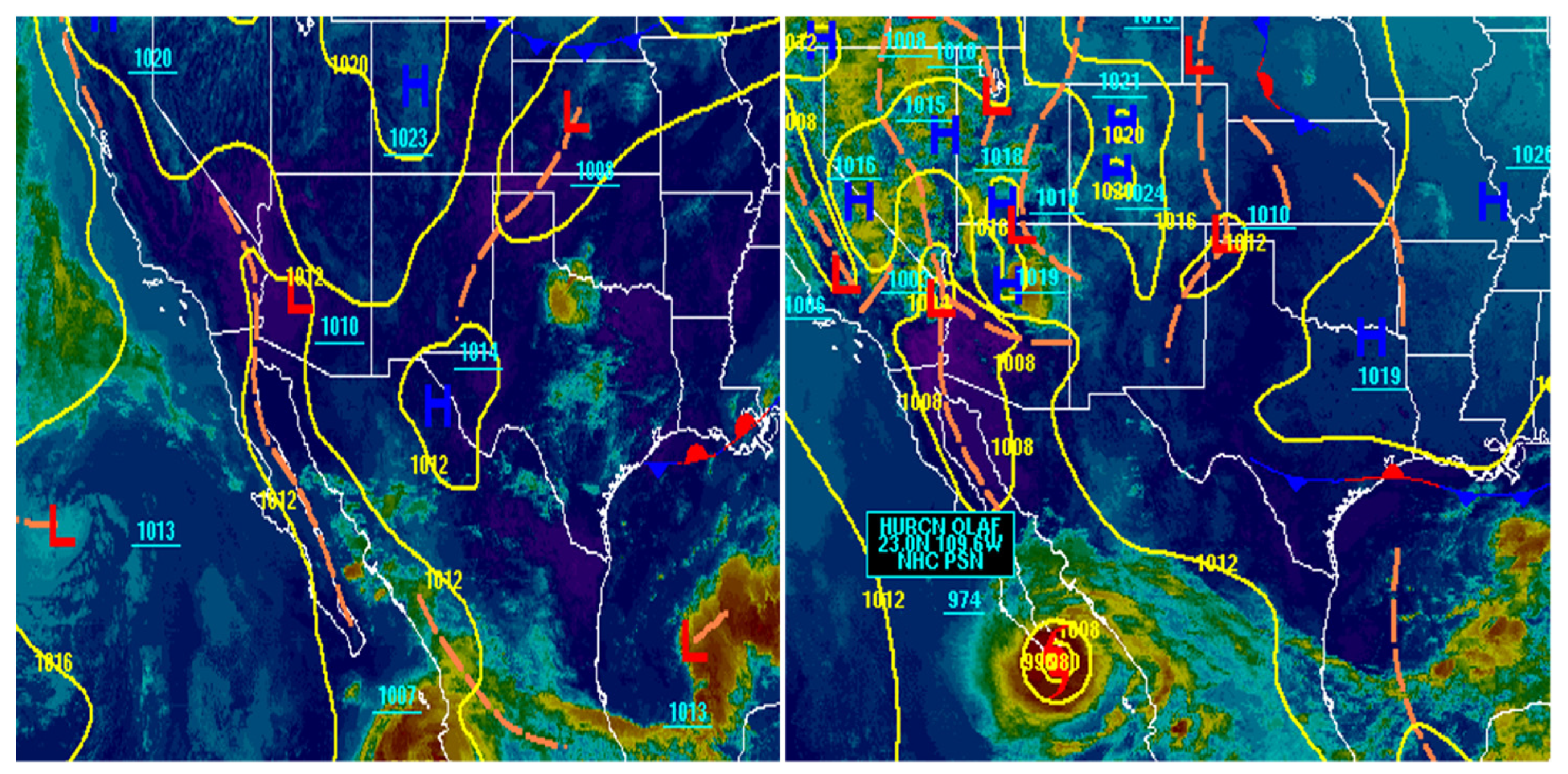
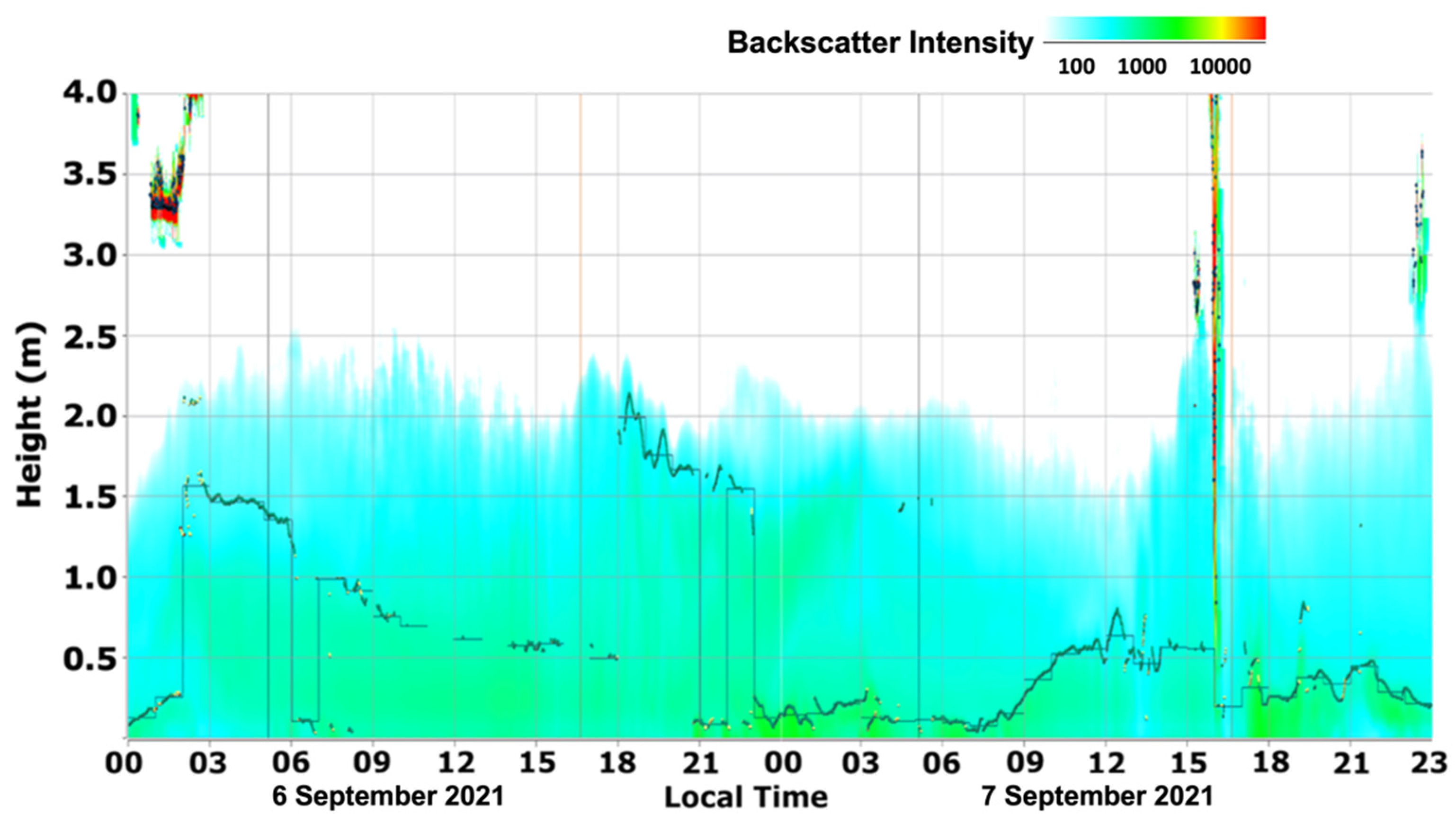
| Parameter | First Peak | Second Peak | Third Peak (3:00 PM—Midnight) | |||
|---|---|---|---|---|---|---|
| BC Babs PAX 405 nm (1/Mm) | 6.130 avg. | 8.188 max. | 2.688 avg. | 4.048 max. | 15.010 avg. | 28.151 max. |
| BC Babs PAX 870 nm (1/Mm) | 2.584 avg. | 3.811 max. | 1.249 avg. | 1.885 max. | 6.975 avg. | 13.105 max. |
| BrC Babs (1/Mm) | 5.171 avg. | 5.896 max. | 4.122 avg. | 4.443 max. | 7.944 avg. | 12.167 max. |
| CO-TCEQ (ppm) | 0.236 avg. | 0.254 max. | 0.231 avg. | 0.300 max. | 0.0341 avg. | 0.462 max. |
| Event Day | Smoke Source State | Event Day | Smoke Source State |
|---|---|---|---|
| 6 August 2021 | CA/NV | 8 September 2021 | CA/OR |
| 7 August 2021 | CA | 9 September 2021 | OR/ID/MT |
| 17 August 2021 | CA/NV | 10 September 2021 | OR/ID/MT |
| 18 August 2021 | CA | 11 September 2021 | NV/ID |
| 20 August 2021 | CA | 13 September 2021 | CA |
| 2 September 2021 | CA/NV/ID | 14 September 2021 | CA |
| 3 September 2021 | CA/NV/ID | 16 September 2021 | CA |
| 6 September 2021 | CA/OR | 17 September 2021 | CA |
| 7 September 2021 | CA/OR/ID | 18 September 2021 | CA/MT |
Publisher’s Note: MDPI stays neutral with regard to jurisdictional claims in published maps and institutional affiliations. |
© 2022 by the authors. Licensee MDPI, Basel, Switzerland. This article is an open access article distributed under the terms and conditions of the Creative Commons Attribution (CC BY) license (https://creativecommons.org/licenses/by/4.0/).
Share and Cite
Lara, P.; Fitzgerald, R.M.; Karle, N.N.; Talamantes, J.; Miranda, M.; Baumgardner, D.; Stockwell, W.R. Winter and Wildfire Season Optical Characterization of Black and Brown Carbon in the El Paso-Ciudad Juárez Airshed. Atmosphere 2022, 13, 1201. https://doi.org/10.3390/atmos13081201
Lara P, Fitzgerald RM, Karle NN, Talamantes J, Miranda M, Baumgardner D, Stockwell WR. Winter and Wildfire Season Optical Characterization of Black and Brown Carbon in the El Paso-Ciudad Juárez Airshed. Atmosphere. 2022; 13(8):1201. https://doi.org/10.3390/atmos13081201
Chicago/Turabian StyleLara, Pamela, Rosa M. Fitzgerald, Nakul N. Karle, Jose Talamantes, Miranda Miranda, Darrel Baumgardner, and William R. Stockwell. 2022. "Winter and Wildfire Season Optical Characterization of Black and Brown Carbon in the El Paso-Ciudad Juárez Airshed" Atmosphere 13, no. 8: 1201. https://doi.org/10.3390/atmos13081201








